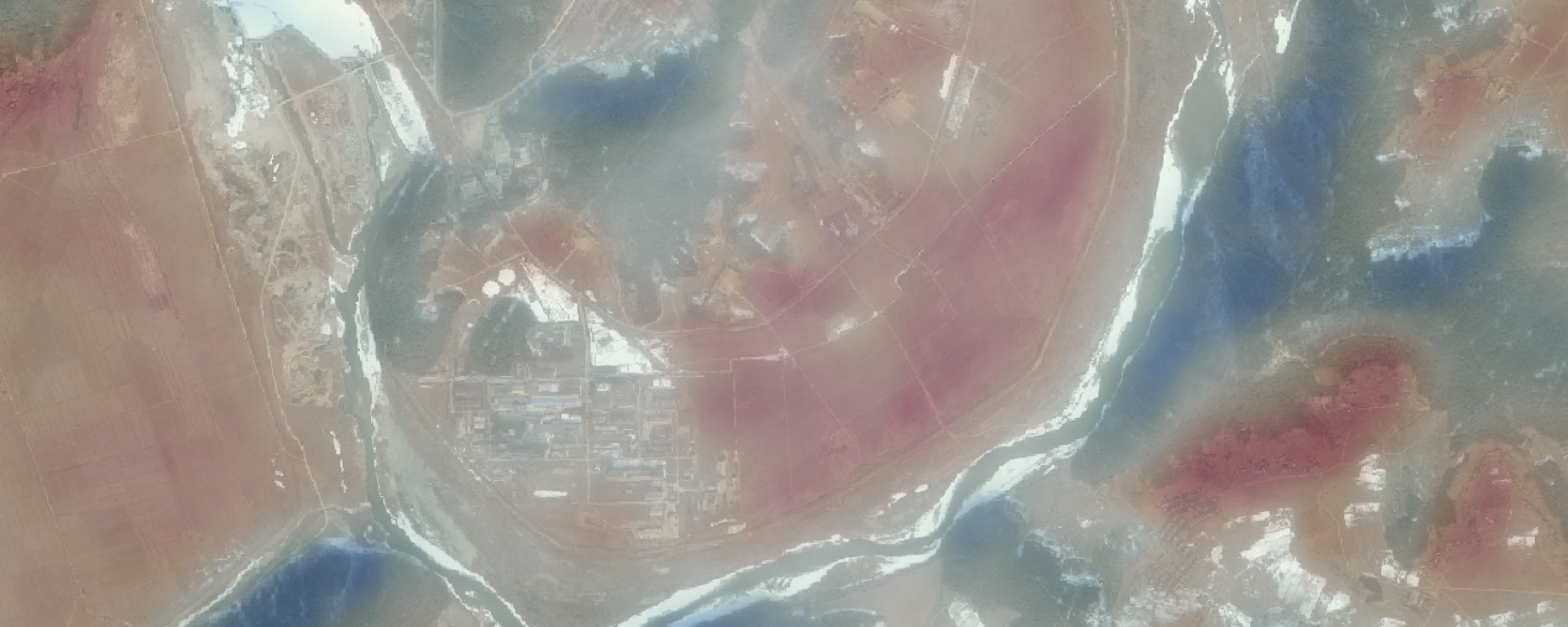
Thermal Imagery Analysis of Continued Activity at Yongbyon

Key Findings
- LANDSAT 7 and LANDSAT 8 thermal infrared satellite imagery in January and February show that warm water is being discharged from the 5MWe Yongbyon reactor, confirming that the reactor and its cooling system are in operation.
- The imagery shows the water around the reactor’s cooling discharge pipe is ice-free, creating a semi-circle of thawed water in an otherwise frozen river.
- Thermal patterns from the same period suggests that the IRT-DPRK reactor, the Radiochemistry Laboratory, and the centrifuge plant are occupied, but not necessarily operational, and not in a state of shutdown.
- This thermal infrared imagery analysis not only supports but also illustrates and expands upon the conclusions in Beyond Parallel’s March 30, 2021, April 15, 2021, and December 8, 2021 reports.
- While we cannot confirm definitively, this activity is an indicator of North Korea’s continuing efforts to expand its inventory of fissile material for nuclear weapons.
As part of continuing coverage of North Korea’s weapons of mass destruction, Beyond Parallel has undertaken a new thermal infrared analysis of the 5MWe and Experimental Light Water reactors at the Yongbyon Nuclear Research Center using NASA LANDSAT 7 and LANDSAT 8 thermal infrared imagery. This analysis examines imagery from January 27 and February 4, 2022, and provides an update of our previous reports.
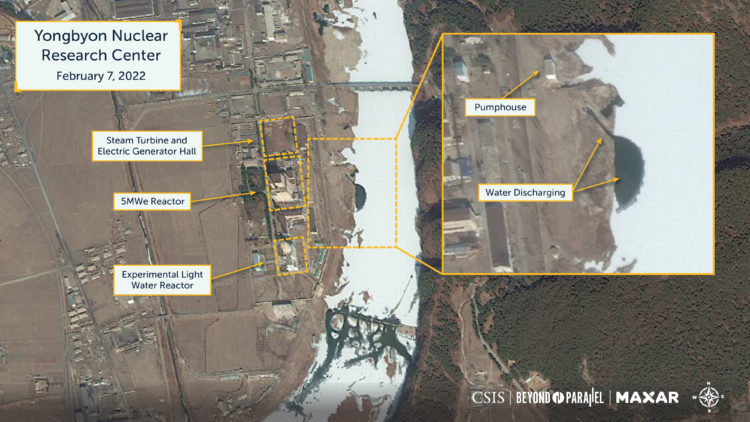
Thermal infrared satellite imagery from late January and early February provides clear evidence that the 5MWe reactor continues to be operated. This imagery confirms that the temperature of the water being discharged from the reactor is warmer than that of Kuryong-gang (Kuryong River). Temperature variations of up to 3 degrees Celsius are observed where the discharged water enters the river. Because of this temperature difference, the area where the water from the reactor discharges into the river has not iced over. In contrast, the deeper areas of the river remain frozen.

The January 27 LANDSAT 7 thermal infrared image was collected on a mostly clear day at 10:00 a.m. local time. The surrounding land surface area is generally free of snow cover and shows typical daytime heating patterns. The relatively shallow river has iced over; however, the area where the warm discharge water enters Kuryong-gang is clear of ice.

This February 4, 2022, LANDSAT 8 imagery was also collected at about 10:00 a.m. local time. Compared to January 27, 2022, this day was 3.5-degree Celsius cooler. The ice cover and opening in the ice near the area where the warm discharge water enters the river has not changed. The thermal pattern in that area of the river also remains consistent, where water temperatures are several degrees warmer than the surrounding parts of the river. These elements indicate that operations at the reactor continue and appear to have remained relatively constant over the past several months.
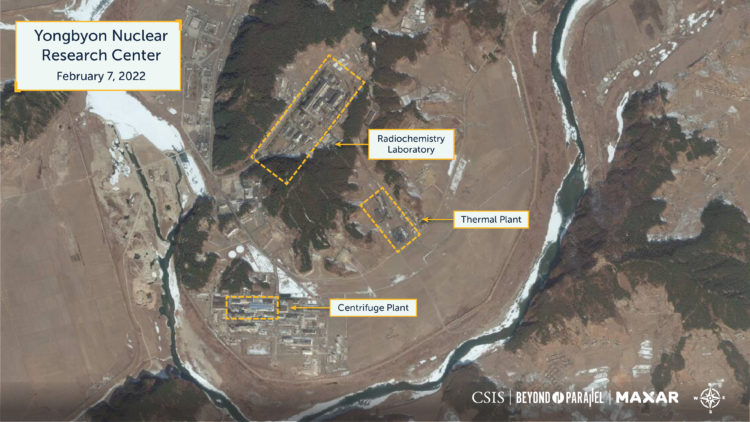
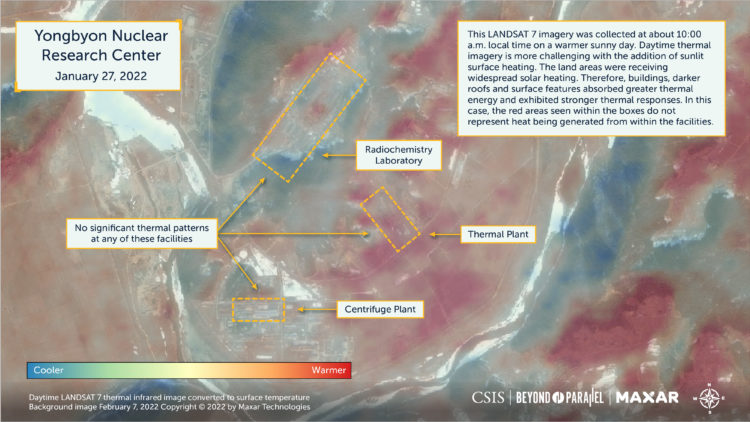
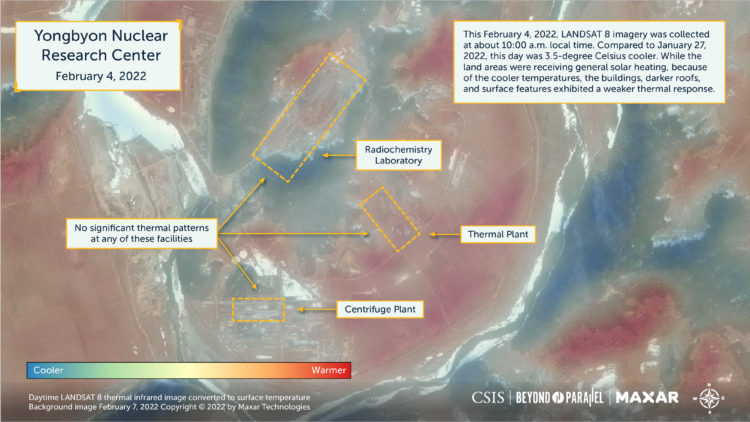
The January 27 and February 4 thermal imagery do not indicate any thermal patterns of significance to suggest that the IRT-DPRK reactor was in operation. It is more challenging to assess the operational status of the Radiochemistry Laboratory, its associated thermal plant, and the centrifuge plant based upon thermal patterns alone. When, however, combined with more traditional multispectral imagery during that same period, there are no strong indications of any significant operational activity at the buildings.
Snowmelt on roofs was observed in multispectral imagery during this period. However, the Radiochemistry Laboratory, thermal plant, and the centrifuge plant have darker roofs and are in locations relatively sheltered from the cold northwest winter winds, which leads to the absorbing of significant amounts of heat. Therefore, the observed snowmelt is likely attributed to the heat absorbed from typical daytime weather and occupation—rather than operation—of the buildings for various activities such as routine maintenance, preparations for future operations, and more. If the Radiochemistry Laboratory, thermal plant, or the centrifuge plant were operational, a much more rapid and generalized melting of snow than is observed in the current thermal and multispectral imagery is expected. More importantly, if the buildings were operational, they would exhibit stronger thermal patterns, as demonstrated in our previous analysis of imagery from March 5, 2021, and March 29, 2021.
